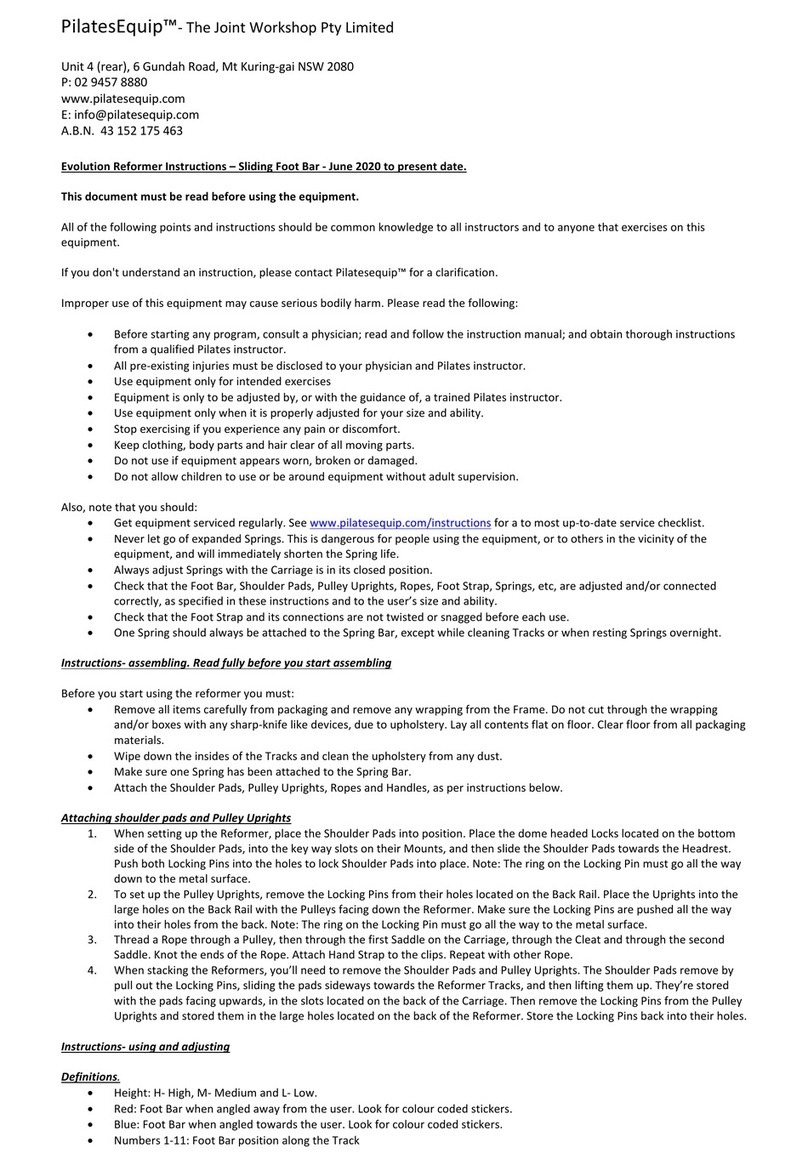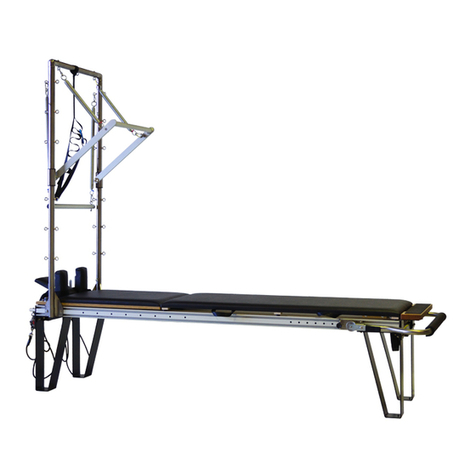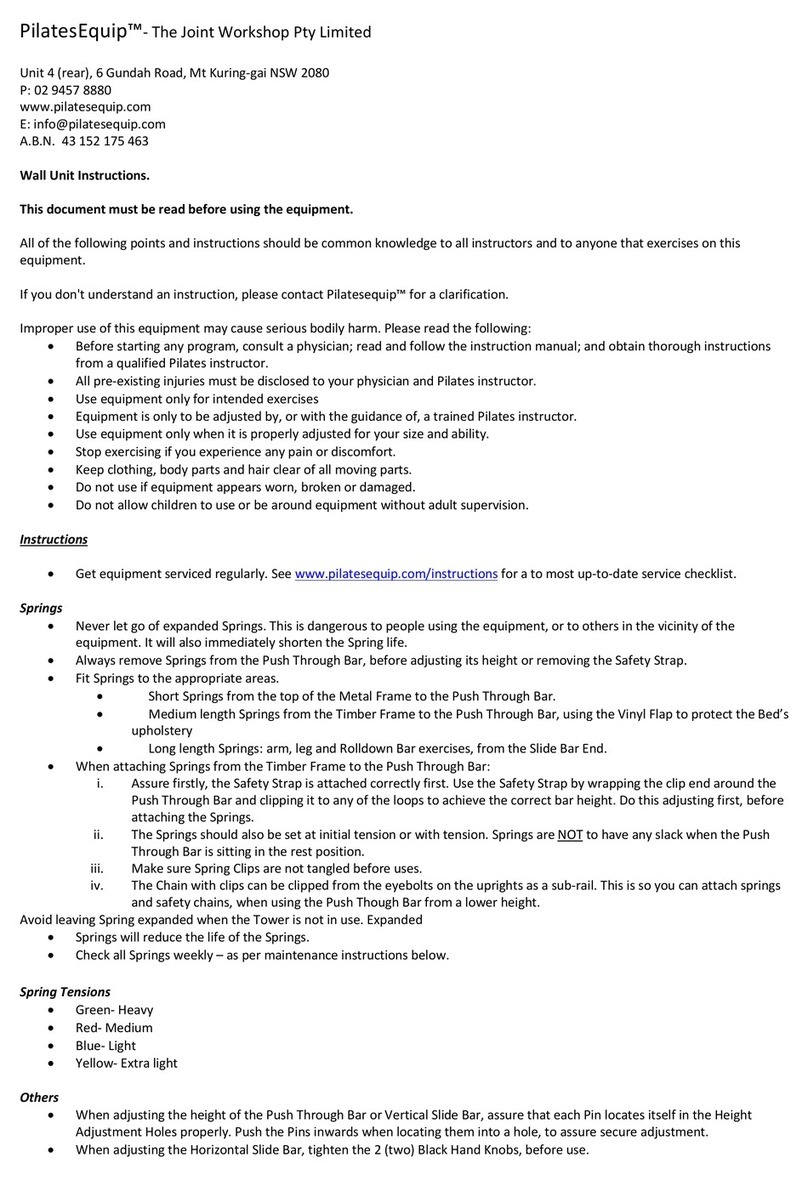
• Blue: Foot Bar when angled towards the user. Look for colour coded stickers.
• Red arrow position: Line up the black Indexing Pins that locks the Foot Bar in place with the hole indicated by the red arrow that’s visible
on the top surface of the Foot Bar Tracks.
Notable foot bar positions
Standard Foot Bar position: M Red angle and the Red Arrow position.
Jump Board: L Red and the Red Arrow position, (refer to the Jump Board instructions below).
Positioning foot bar along the tracks
• Pull out both of the black Indexing Pins that lock the Foot Bar to the Tracks. You’re now able to slide the Foot Bar up and down the
Reformers Tracks.
• Helpful Hints: The best way to do this is by applying a slow even pulling or pushing force, to each side of the Foot Bar. Placing the Foot Bar
angle to high also helps.
• Slide the Foot Bar to its required position by aligning the black Indexing Pins on the Foot Bar components, with a hole in the Foot Bar Track.
Check both Indexing Pins, making sure they lock back into the holes.
Jump Board
Adjust the Foot Bar to the correct Jump Board position- L Red and the Red Arrow position. Loosen the black Jump Board Knobs located on the outside
of the Front Rail, to allow the Jump Board to fit into the Jump Board Bracket. Slot the Jump Board into the Jump Board Bracket, located on the inside
of the Front Rail. Secure the Jump Board into place by tightening the Jump Board Knobs. When using the Jump Board, the Foot Bar should now be in
position directly behind the Jump Board, so it’s supported during use. When removing the Jump Board, loosen the Jump Board Knobs and wobble the
Jump Board back and forth to help with its removal.
Stopper Plate
Place the Rubber Stopper in the first hole of the Stopper Plate, located under the Track near the front of the Carriage. This is its standard position.
Adjust when needed to suit the user’s size and ability. Always use the Reformer with the Reformer Stopper in place.
Spring tensions
• Green- Heavy, full tension.
• Red- Medium, ¾ tension.
• Blue- Light, ½ tension.
• Yellow- Extra light, ¼ tension
Resting Springs.
Avoid leaving Springs expanded when Reformer is not in use. Expanded Springs will reduce the life of the Springs.
At the end of the day or when the Reformer is not in use, you should rest the Springs. This will help prolong the life of the Springs. It’s best to bring
the Rubber Stopper to the first hole in the Stopper Plate, so the Springs are in initial position. Initial position is when the Spring is attached to the
hook but has the least amount of expansion on the Spring. Alternately, you can remove all Springs from the Spring Bar Hooks and roll the Carriage to
the back of the Reformer. This helps indicate to the user that the Springs are not connected.
Maintenance.
• Get equipment serviced regularly. See www.pilatesequip.com/instructions for a to most up-to-date service checklist.
• Clean all vinyl upholstery daily, as a minimum. Make sure you clean Shoulder Pads, Head Rest and Bed. Use a mixture of water and some
ordinary mild “Sunlight Pure Soap”, cut into little flakes and placed in a spray bottle. Clean with a towel, cloth or paper towel. NOTE: Don’t
use other products such as chemicals, bleach, tea tree or eucalyptus oils, alcohol wipes or methylated spirits, or detergents- as they
deteriorate vinyl. Human sweat also causes vinyl deterioration. The vinyl has an antibacterial coating and doesn’t need harsh cleaners.
• Check all Springs weekly. Note: If any of the below issues occur, replace Springs immediately.
i. Check springs by slightly stretching the Spring from the Spring's Loops or Clips at the end of the Spring, until the coils just start to
open. If a small section of the Spring Barrel separates while the rest of the coils remain close, the Spring is faulty.
ii. Look for obvious bend/kinks in the Spring's barrel.
iii. Make sure that Spring's Loops haven't travelled up the Spring's coned coils.
iv. Check age of springs. It’s recommended to replace Reformer Springs that are older than 8 years.
• Clean all Tracks and Wheels a minimum of once a week.
i. Clean Tracks by wiping with damp rag. Wipe the front and the back of the Tracks, by moving the Carriage back and forth. If
there's built-up of dirt balls, lightly rub with a fine green Scotch-Brite pad.
ii. Clean Wheels by wiping with damp rag. Place rag on Wheel and move the Carriage back and forth. If there's built-up of dirt,
lightly rub with a fine green Scotch-Brite pad.
• Check Reformer regularly for any worn parts or problems. Bolts and nuts that may vibrate lose should be addressed, without delay.
Packing List
o Timber Frame
o Carriage
o M8 washers x 8
o M8x75mm bolts x 4
o M8 hexagonal nyloc nuts x 4
o Stop Plug x 1
o Foot strap x 1
o D-loop handles x 2
o Ropes x 2
o Pulleys + uprights x 2
o Jump Board x1
Optional Extras
o Padding for the Jump Board
o Reformer Foot Platform Extender
o Half Trapeze Tower
o Reformer Conversion Mat






















